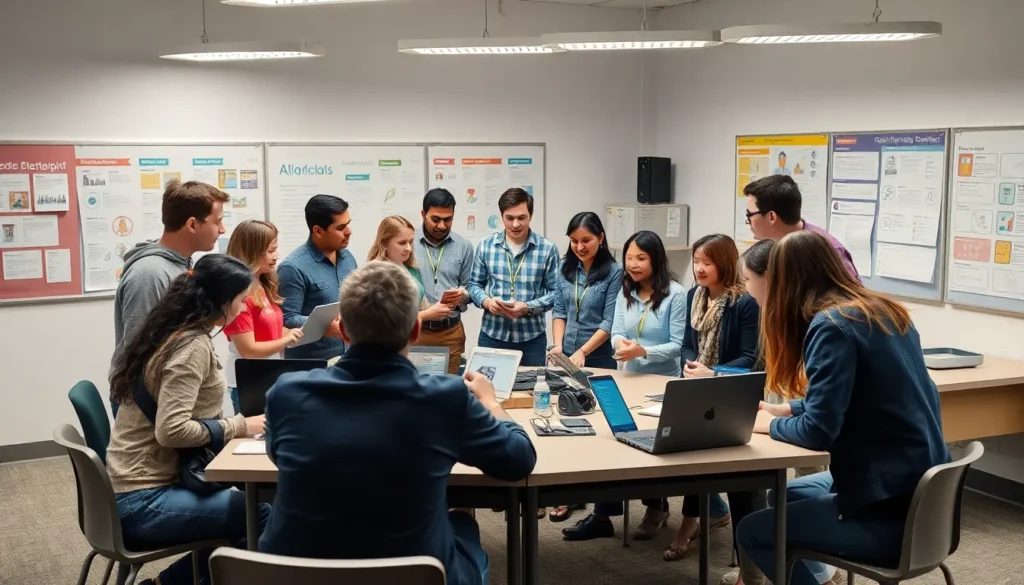Table of Contents
ToggleIn the rapidly evolving world of education technology, the EdTech community stands as a vibrant hub of innovation and collaboration. Picture a bustling marketplace where educators, developers, and enthusiasts gather, swapping ideas like trading cards. It’s not just about fancy apps and sleek platforms; it’s about fostering connections that spark creativity and drive change in classrooms everywhere.
Overview of EdTech Community
EdTech community represents a vibrant ecosystem where various stakeholders engage in collaboration and innovation. This community includes educators, software developers, entrepreneurs, and learners who all share a common goal: enhancing educational experiences through technology. Active participation fosters relationships that drive creativity and inspire new approaches to teaching and learning.
Technology’s integration into education reshapes traditional practices, promoting flexibility and accessibility. Forums, webinars, and events provide platforms for members to exchange ideas, share resources, and showcase successful initiatives. Collaboration among educators encourages the sharing of best practices, enabling them to adapt and thrive in rapidly changing environments.
Support structures within the EdTech community help ensure that all voices are heard. Organizations often offer mentorship programs, allowing experienced professionals to guide newcomers. Networking opportunities within this space facilitate partnerships that lead to innovative EdTech solutions.
Research indicates that communities significantly impact professional development, inspiring educators to embrace new tools and methodologies. Engaging with peers offers insights into effective strategies for integrating technology into curricula and assessments. Collaboration helps bridge gaps between different educational approaches, enabling a more comprehensive understanding of diverse learner needs.
Emphasis on inclusivity strengthens the EdTech community. Diverse perspectives enrich discussions and contribute to richer educational experiences. As stakeholders actively engage in dialogue, they cultivate an environment where everyone can contribute to enhancing learning outcomes.
Overall, the EdTech community thrives on collective efforts that champion transforming educational practices. Collaboration, innovation, and inclusivity remain cornerstones of this dynamic network, ensuring that technology serves as a catalyst for positive change in education.
Key Players in the EdTech Community

The EdTech community consists of various influential stakeholders who drive innovation and collaboration within this dynamic sector.
Startups and Innovators
Startups play a crucial role in developing new technologies and solutions that enhance learning experiences. Innovators often bring fresh ideas to the table, focusing on user-friendly designs and engaging educational content. Through agile methodologies, these small but dynamic entities adapt quickly to emerging trends and needs. With funding from investors drawn to their potential, startups can scale their solutions rapidly. For example, platforms that facilitate personalized learning are revolutionizing the way educators approach instructional design.
Educational Institutions
Educational institutions serve as vital centers for adopting and integrating technology into curricula. Schools and universities continually seek innovative tools to enhance teaching and learning experiences. Collaborations between institutions and tech developers enable the implementation of customized solutions that address specific educational challenges. Many institutions host pilot programs for new technologies, allowing feedback from educators and students to refine these tools. As a result, they become essential contributors to the EdTech ecosystem, helping bridge gaps between traditional methods and modern practices.
Non-Profits and NGOs
Non-profits and NGOs actively support the EdTech community by advocating for equitable access to education technology. These organizations often focus on underserved populations, ensuring technology reaches those who benefit most. By providing resources, training, and funding, they empower educators to effectively adopt new tools. Initiatives led by non-profits often promote critical thinking and digital literacy among students. Partnerships with tech companies can lead to the development of impactful programs that enhance educational opportunities, extending their reach to diverse communities.
Benefits of Joining the EdTech Community
Joining the EdTech community offers numerous advantages, fostering an environment that promotes growth and innovation. Enhanced connections among members pave the way for enriched educational practices.
Networking Opportunities
Networking opportunities abound within the EdTech community. Educational events and conferences provide platforms for face-to-face interactions. Engaging with peers and thought leaders opens avenues for collaborations. Members gain access to a broad network of professionals, which often leads to mentorship and partnership possibilities. Building strong relationships plays a crucial role in professional advancement and career growth.
Knowledge Sharing
Knowledge sharing stands as a cornerstone of the EdTech community. Members frequently exchange ideas on best practices and innovative strategies. Access to diverse perspectives enables newcomers to learn from experienced professionals. Webinars, podcasts, and articles serve as invaluable resources for continuous learning. Cultivating a culture of sharing fosters an atmosphere where everyone benefits, enhancing overall expertise and educational outcomes.
Collaboration and Support
Collaboration and support are integral to the EdTech community’s success. Working together on projects leads to innovative solutions that enhance learning experiences. Collaborative efforts often include educators, developers, and entrepreneurs, ensuring a holistic approach to problem-solving. Support structures, like mentorship programs, empower individuals to take risks and explore new methodologies. A strong sense of community encourages members to seek assistance, share resources, and celebrate achievements collectively.
Challenges Facing the EdTech Community
Challenges abound in the EdTech community, impacting innovation and collaboration. Key issues include access and equity concerns, along with technological barriers.
Access and Equity Issues
Access to technology remains uneven across various demographics. Schools in underserved areas often lack adequate resources, limiting students’ learning opportunities. A significant number of families experience challenges affording devices and reliable internet connections. Additionally, diverse learning needs require tailored solutions, which not all providers offer. Organizations focused on equity advocate for better access through funding and resources, highlighting the importance of inclusive practices in educational technology.
Technological Barriers
Technological barriers hinder effective implementation within classrooms. Limited infrastructure in some schools creates difficulties for adopting advanced tools and platforms. Teachers often feel unprepared to navigate new technologies, impacting their confidence in using them. System compatibility issues between various software applications may lead to frustration among educators. Continuous professional development opportunities remain essential for overcoming these challenges, ensuring educators gain the skills and knowledge needed to utilize technologies efficiently.
Future Trends in the EdTech Community
Innovations in the EdTech community shape how teaching and learning evolve. These trends reflect emerging technologies and global expansion, paving the way for transformative educational experiences.
Emerging Technologies
Artificial intelligence becomes a key player in personalized learning, adapting content to meet individual learner needs. Virtual reality immerses students in engaging environments, enhancing comprehension and retention. Blockchain technology improves credential verification, streamlining processes for institutions and learners. Advanced data analytics helps educators make informed decisions based on student performance insights. Furthermore, mobile learning applications facilitate education access anywhere, catering to diverse student lifestyles. Each of these technologies contributes to creating a more interactive and engaging learning experience.
Global Expansion
International collaborations enrich the EdTech landscape, fostering diverse educational practices. Increasing internet penetration in developing regions opens doors to digital content and remote learning. Partnerships among tech companies, educators, and NGOs support sustainable access to learning resources across continents. Multilingual platforms cater to varied populations, promoting inclusivity in educational content. Additionally, expanding educational initiatives focus on underserved areas, ensuring equitable access to technology. These global efforts strengthen the EdTech community, enhancing educational quality worldwide.
Conclusion
The EdTech community stands as a beacon of collaboration and innovation in education. By fostering connections among educators, developers, and learners, it cultivates an environment ripe for transformative ideas and practices. This vibrant ecosystem not only enhances teaching and learning experiences but also addresses challenges related to access and equity.
As technology continues to evolve, the community’s commitment to inclusivity and support remains crucial. Engaging with diverse perspectives enriches discussions and paves the way for innovative solutions. The future of education technology is bright, driven by collective efforts that prioritize collaboration and creativity. Through shared knowledge and resources, the EdTech community is poised to redefine educational landscapes and improve learning outcomes for all.







